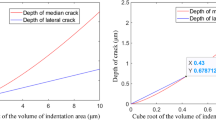Abstract
The SPH simulation model of optical quartz glass was established to study the ductile machining process with different tool rake angles. The material removal mode, stress distribution, cutting force, and subsurface damage during machining were analyzed. The critical cutting depths of brittle-ductile transition under different tool rake angles were obtained. The simulation results show that the tool negative rake angle is better than the positive rake angle in promoting the ductile machining of optical quartz glass. When the tool rake angle is negative, significant compressive stress which suppresses the crack generation by reducing the stress intensity factor KI is generated in the chip forming area, thus realizing the ductile machining of optical quartz glass. The greater the tool negative rake angle is, the more stable the cutting force and the greater the critical cutting depths of brittle-ductile transition are. When the tool negative rake angle is greater than − 35°, the subsurface damage of the optical quartz glass is aggravated, and the subsurface residual stress is complicated. When the tool negative rake angle ranges from − 15° to − 35°, the optical quartz glass is not only machined in a stable ductile region but also has less subsurface damage. Finally, nano-scratch experiments were carried out, and the critical depths of the brittle-ductile transition obtained by the experiments are basically consistent with the simulation results, which verify the correctness of the simulation results. The research results in this paper could provide a theoretical basis for the optimal selection of tool rake angle in the ductile machining of optical quartz glass.












Similar content being viewed by others
References
Chi HJ, Gao X, Zhao DF, Lin JQ (2014) Study on influence of HF acid treatment on 355 nm laser damage of quartz glass [J]. Laser Infrared 44(09):987–990 (in Chinese)
Chen J, Fang Q, Li P (2015) Effect of grinding wheel spindle vibration on surface roughness and subsurface damage in brittle material grinding[J]. Int J Mach Tool Manu 91:12–23
Ma L, Gong Y, Chen X (2014) Study on surface roughness model and surface forming mechanism of ceramics in quick point grinding[J]. Int J Mach Tool Manu 77(2):82–92
Zhu YW, Li XL, Wang ZK, Ling SZ (2017) Subsurface damage prediction for optical hard-brittle material in fixed abrasive lapping[J]. Opt Precis Eng 25(2):367–374 (in Chinese)
Zhang YZ, Pi J (2013) Advances in the Research on ductile regime machining of brittle materials [J]. J Jimei Univ (Nat Sci) 18(1):38–47 (in Chinese)
Neo WK, Kumar AS, Rahman M (2012) A review on the current research trends in ductile regime machining[J]. Int J Adv Manuf Technol 63(5–8):465–480
Wu HB, Zuo DW, Sun QP, Xu F, Sun YL (2015) Research on ductile regime milling of fully sintered dental zirconia [J]. Trans Beijing Inst Technol 35(9):902–907 (in Chinese)
Li ZP, Zhao H, Zhang FH (2016) Study on the ductile removal behavior of K9 glass with nano-scratch [J]. Adv Mater Res 1136:282–288
Guo B, Zhao QL (2015) Wheel normal grinding of hard and brittle materials [J]. Int J Adv Manuf Technol 79(5–8):1–8
Li C, Zhang FH, Ding Y, Liu LF (2016) Surface deformation and friction characteristic of nano scratch at ductile-removal regime for optical glass BK7 [J]. Appl Opt 55(24):6547
Zhou M, Zhao PY (2016) Prediction of critical cutting depth for ductile-brittle transition in ultrasonic vibration assisted grinding of optical glasses [J]. Int J Adv Manuf Technol 86(5–8):1775–1784
Xiang Y, Chen J, Bai MS, Ren J, Zhang JK (2014) Experimental study of brittle-ductile translation critical conditions in Li2 O-Al2 O3-SiO2 glass-ceramic machining [J]. J Appl Opt 35(3):500–504 (in Chinese)
Ma LJ, Wang H, Gu LC, Shan Q, Yang JY, Yu AB (2016) Study on the surface critical conditions of engineering ceramics [J]. New Technol New Process (3):94–96 (in Chinese)
Wang Y, Wang S, Liu JG, Xiong W (2015) Dynamic simulation of single abrasive grain cutting TC4 based on SPH method [J]. J Syst Simul 27(11):2865–2872 in Chinese
Mir A, Luo XC, Sun JN (2016) The investigation of influence of tool wear on ductile to brittle transition in single point diamond turning of silicon [J]. Wear 364-365:233–243
Lu CY, He J, Li HW, Wang QJ, Zheng ZQ, Zhang XC (2014) Simulation of soil cutting process of plane knife based on SPH algorithm [J]. Trans Chin Soc Agric Mach 45(8) (in Chinese)
Li J (2015) Research on characteristics of the transition of ductile-brittle in laser and ultrasonic vibration assisted cutting of hard alloy [D].Henan Polytechnic University. (in Chinese)
Bifano TG, Dow TA (1991) Ductile regime grinding: a new technology for machining brittle materials [J]. J Eng Ind 113:184–189
Guo XG, Wei YJ, Jin ZJ, Guo DM, Wang MS (2013) A numerical model for optical glass cutting based on SPH method [J]. Int J Adv Manuf Technol 68(5–8):1277–1283
Bridgman PW, Simon I (1953) Effects of very high pressures on glass [J]. J Appl Phys 24(4):405–400
Liu K, Li XP, Liang SY (2007) The mechanism of ductile chip formation in cutting of brittle materials [J]. Int J Adv Manuf Technol 33(9–10):875–884
Nomura KI, Chen YC, Kalia RK, Nakano A, Vashishta P (2011) Defect migration and recombination in nanoindentation of silica glass [J]. Appl Phys Lett 99:111906
Acknowledgments
The authors would like to acknowledge the financial support from the National Natural Science Foundation of China (General Program) (No. 51575083), the Key Program of the National Natural Science Foundation of China (No. 51735004) and Fundamental Research Funds for the Central Universities (DUT19LAB15).
Author information
Authors and Affiliations
Corresponding author
Additional information
Publisher’s note
Springer Nature remains neutral with regard to jurisdictional claims in published maps and institutional affiliations.
Rights and permissions
About this article
Cite this article
Guo, X., Zhai, R., Kang, R. et al. Study of the influence of tool rake angle in ductile machining of optical quartz glass. Int J Adv Manuf Technol 104, 803–813 (2019). https://doi.org/10.1007/s00170-019-03920-x
Received:
Accepted:
Published:
Issue Date:
DOI: https://doi.org/10.1007/s00170-019-03920-x




